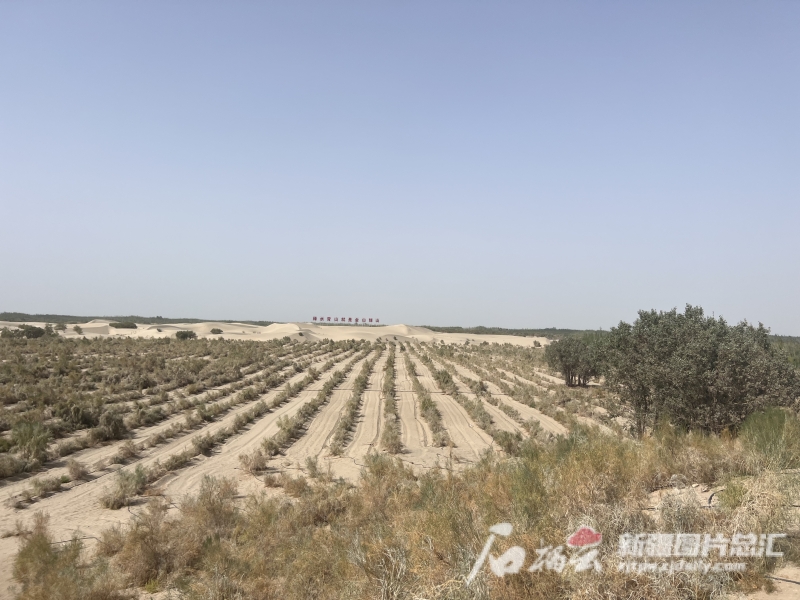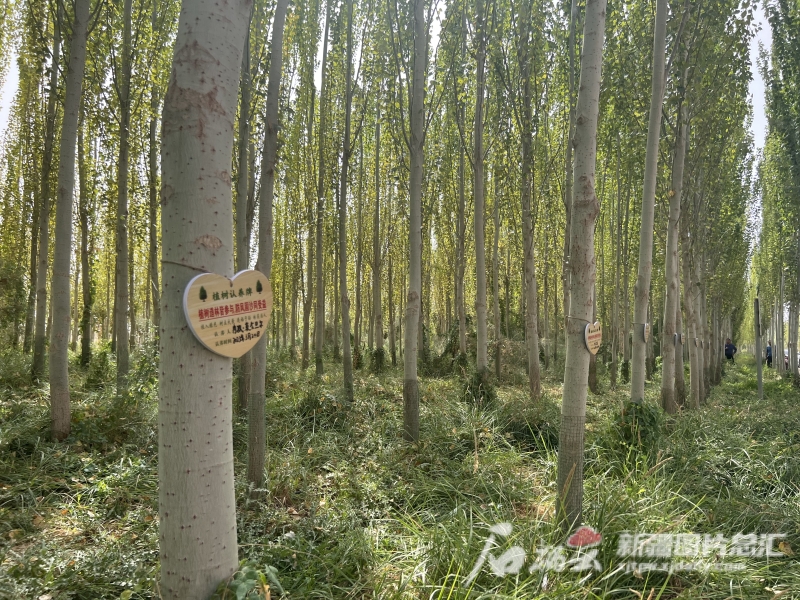Shiliuyun-Xinjiang Daily (Reporter Kang Haoyan) news: Sitting 5 kilometers away from the Taklimakan desert, Makit County in the Kashgar Prefecture, northwest China's Xinjiang Uygur Autonomous Region used to be plagued by sandstorms and drift sand. After ten years of arduous efforts, a green ecological barrier spanning 50 kilometers and extending 20 kilometers has been built on the barren land, which acts as a guardian that protects millions of mu of farmland and the people living here.

Photo shows the sacsaoul trees (haloxylon ammodendron) in the desert. (Photo by Kang Haoyan)
This is a project of building 1 million mu of sand-fixing forests in Makit County.
About 5 kilometers from the Kumukusaer Township in the east along Township Road 382, reporters entered the ecological forest on September 7, 2023. Standing at a high place and looking down, one can get a view of the neatly arranged desert poplar (Populus euphratica) trees and oleaster trees extending all the way to the horizon. The golden desert with undulating sand dunes on the east side of the lush forest makes an astoundingly harmonious picture.
“The ecological environment in the entire county has significantly improved, with sandstorm weather reduced from over 150 days to less than 50 days, and annual precipitation increased from 56.5 millimeters to 110 millimeters,” said Yin Honghai, the director of the Makit County Desertification Prevention and Control Center. He introduced that the project of planting 1 million mu of sand-fixing forests started in 2012. Since then, 100,000 cadres and people of all ethnic groups have been working in the desert every spring and autumn. After years of practice, they learned experience about desert afforestation such as soil replacement and drilling wells in the desert. In the spring of 2022, the forest areas in the north and south of the county have been integrated, forming a large ecological forest of 460,000 mu between Makit County and the Taklimakan Desert.
The phase 1 project of tree planting has been finished, and the phase 2 project is progressing in an orderly manner. How do the 260 million trees in the ecological forest survive under conditions of limited water resources, obstacles on maintenance, and tight financial budget?
“We need to subdivide different tree species for precise watering, so as to achieve maximum ecological benefits with the least amount of water,”said Adil Mamat, a cadre of Makit County Desertification Prevention and Control Center. At the beginning of the project, the smart drip irrigation was introduced. Nowadays, smart and automated facilities in the forest can timely sense the water demand and real-time water supply situation of trees, achieving optimal drip irrigation water supply. At the same time, the smart drip irrigation will make rotation irrigation plans for different trees, such as making according irrigation plans for poplar trees with higher water demand and for sacsaoul trees and oleaster trees with lower water demand. In this way, the average annual water consumption per mu in the ecological forests now is 200 cubic meters, which is much lower than the annual water consumption of conventional forests of 300-400 cubic meters.
At present, 450 pumping wells have been put into use, and 460,000 mu of drip irrigation belts have been laid in the forest. In addition, over 260 million ecological trees such as white poplar (Populus alba var. pyramidalis Bunge), Xanthoceras sorbifolia, Populus euphratica, Elaeagnus angustifolia, seabuckthorn, red willow, the sacsaoul trees, and trees with economic value such as apples and plums. The overall survival rate of various types of trees has reached over 95%.

Photo shows a ranger removes the sand in the forest. (Photo by Kang Haoyan)
Ranger Abdukadir Kamil and his colleagues occasionally picked up the junctions of the drip irrigation pipe, opened up the junctions of the pipe, shook the sand out, and then reattached them. “This is what we do to remove the sand and the rust once a week to ensure that the drip irrigation system works,” said Abdukadir. Growing up in Tumantale Township of Makit County, weather of wind and sand would occur half of the year when he was a child. When afforestation projects were carried out, he and his family actively participated every year. Now that the ecological environment in his hometown has improved, he has become a forest ranger working for the maintenance of 1800 mu of forest land.
People in need in Makit County are encouraged to participate in the“under-forest economy” and work for the management and protection of the ecological forest. The project has successively driven more than 150 households in the county to participate in ecological forest management and protection, achieving employment for 270 people with an average annual income of nearly 40,000 yuan per household.

Photo shows the trees in the ecological forest that are “adopted” by the neighboring residents or volunteers all over the country. (Photo by Kang Haoyan)
“We actively explore a new model of ecological construction with diversified investment and multi-party participation in afforestation management and protection, led by the government, participated by enterprises, supported by projects, and guaranteed by technology,” said Yin Honghai. Since 2012, enterprises, universities and organizations, such as Sun Yat-Sen University, have invested in the construction of wind-break and sand-fixation in the ecological forests in a way of “adoption”, integrating and bundling projects such as Three-North Shelter Forest Program and Prevention and Control of Desertification Project, providing continuous support for the maintenance, operation, and continuous expansion of the ecological forest.

Photo shows 10 years of afforestation history displayed in the exhibition hall of the the ecological forest construction center in Makit County, Kashgar Prefecture, northwest China's Xinjiang Uygur Autonomous Region. (Photo by Kang Haoyan)
In the exhibition hall of the ecological forest construction center, a dazzling array of products, such as freeze-dried cistanche, apocynum, oleaster honey, attract the attention of visitors. Makit County relies on ecological forests to develop “under-forest planting and breeding”. In 2016, it established the Daolang Ecological Cistanche Forest Economic Demonstration Base. Based on 260,000 mu of sacsaoul trees, it has been vigorously developing sand industry that focuses on sacsaoul and cistanche with 65,000 mu of them being planted now. This year, 20,000 mu of sacsaoul and cistanche have been harvested in rotation, with an estimated annual output value of 40 million yuan. The products are mainly sold to China’s coastal provinces such as Shanghai, Guangdong, and Anhui. In 2021, the base was rated as a national demonstration base of “under-forest economy”, offering more than 100 jobs. Every year, the base will also proportionally give back to invest in the expansion of the ecological forest.
“Not only do we need to maintain the status quo, but we also need to make expansion,” said Yin Honghai. We need to make more efforts to develop the sand industry and control desertification, thus helping farmers to live a well-off life and increase income, which will effectively promote the orderly progress of the second phase of the project of building a 1 million mu of sand-fixing forests.
(A written permission shall be obtained for reprinting, excerpting, copying and mirroring of the contents published on this website. Unauthorized aforementioned act shall be deemed an infringement, of which the actor shall be held accountable under the law.)









